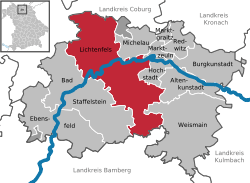Lichtenfels, Bavaria
| Lichtenfels | ||
|---|---|---|
| ||
 Lichtenfels | ||
Location of Lichtenfels within Lichtenfels district  | ||
| Coordinates: 50°08′N 11°02′E / 50.133°N 11.033°ECoordinates: 50°08′N 11°02′E / 50.133°N 11.033°E | ||
| Country | Germany | |
| State | Bavaria | |
| Admin. region | Oberfranken | |
| District | Lichtenfels | |
| Government | ||
| • Erster Bürgermeister | Andreas Hügerich (SPD) | |
| Area | ||
| • Total | 122.27 km2 (47.21 sq mi) | |
| Population (2015-12-31)[1] | ||
| • Total | 20,169 | |
| • Density | 160/km2 (430/sq mi) | |
| Time zone | CET/CEST (UTC+1/+2) | |
| Postal codes | 96215 | |
| Dialling codes | 09571 | |
| Vehicle registration | LIF | |
| Website | www.lichtenfels-city.de | |
Lichtenfels is a town in the Upper Franconian region of Bavaria, Germany, the administrative seat of Lichtenfels district. It is chiefly known as the German "Basket City".
Geography
It is situated on the upper course of the river Main (pronounced like the English word "mine"), about 15 kilometres (9.3 mi) southeast of Coburg, and 30 kilometres (19 mi) northeast of Bamberg. The hilly landscape is called Gottesgarten am Obermain ("God's garden on the upper Main"), referring to the Basilica of the Fourteen Holy Helpers and Banz Abbey.
The district of Lichtenfels lies in the western part of the government region (Regierungsbezirk) of Oberfranken (Upper Franconia). It is surrounded by (from the north and clockwise) the districts of Coburg, Kronach, Kulmbach, Bayreuth and Bamberg.
The district is shaped by the river Main. The Maintal (valley of the Main) goes from East to West. The most important Cities of the district are Burgkunstadt, Bad Staffelstein and the district city of Lichtenfels.
Incidental rivers from the river of Main is the surrounded area Rodach,where from the northern part between Hochstadt am Main and Lichtenfels lead and it is the greatest.
The Southern bank of the Main stretches up to the mountain range of the Franconian Jura (Fränkische Alb) beneath the Staffelberg close to Bad Staffelstein. The Northern bank of the Main stretches up to the Itz-Baunach-Highlands.
City Division
The city is divided into several districts:
Buch am Forst, Degendorf, Eichig, Gnellenroth, Hammer, Isling, Klosterlangheim, Kösten, Köttel, Krappenroth, Lahm, Mistelfeld, Mönchkröttendorf, Oberlangheim, Oberwallenstadt, Reundorf, Roth, Rothmannsthal, Schney, Schönsreuth, Seehof, Seubelsdorf, Stetten, Stöcken, Tiefenroth, Trieb, Unterwallenstadt und Weingarten.
History
Lichtenfels was first mentioned in 1142 and chartered in 1231. That was titled and conferred from Otto III, Count Palatine of Burgundy.
After the expiration of the Meranier in 1248 Lichtenfels became part of the Hochstift Bamberg. With those and with the Säkularisation in 1802 incorporate to the Prince-electorate (Kurfürstentum) and later to the Kingdom of Bavaria (Königreich Bayern).
The Lichtenfelser are also called, in a sneering kind of way, the scoopers of the pool (Tümpelschöpfer). This name they obtained from the Thirty Years' War (1618 - 1648), from attempting to retrieve hidden sunken treasures in a pond, which they could not empty out due to rapidly running groundwater.
Basket City
Lichtenfels became a centre of basket making in the middle of the 19th century. The basket makers in the surrounding upper Maintal area brought their products to trade in Lichtenfels, which was and is the biggest retail market. The leading entrepreneur was the basket dealer Joseph Crinkly.
Since 1904, there has been a technical basket college, and as of 1912 there was also a braiding course for women. Those fashioned and very frequent outwork baskets came from the whole family.
After the First World War Lichtenfels became known as the German wicker chair. The period saw the gradual extinction of basket making in Germany. After the Second World War Lichtenfels was the main remaining basket dealer and today as an exclusive exporter of the braiding manufactures.
Lichtenfels is the basket-making capital of Germany and has the only college which still teaches the old craft skills. Each year at the end of September the Korbmarkt (basket market) is held when the town is filled with stalls selling baskets from many countries and one can watch many craftspeople at work. On the Market Place in front of the Town Hall you can see the World's largest gift basket.
 the Korbmarkt
the Korbmarkt the korbmarkt
the korbmarkt
Local economy
Owing to the success of numerous local middle class enterprises, the town of 21,500 has an above average occupational quota.
The backbone of the local economy is formed by businesses in various industry sectors such as manufacturing, with an upholstery industry and its suppliers as well as wood processing and the production of foamed material. Other businesses include machine and tool fabrication, laser technology and one international cargo carrier.
Famous people
- Thomas Dehler
- Stefan Kießling
- Hans Nagler
- Reinhard Huetter
Twin cities
 Ariccia, Italy
Ariccia, Italy Cournon-d'Auvergne, France
Cournon-d'Auvergne, France Prestwick, Scotland
Prestwick, Scotland Vandalia, United States
Vandalia, United States
References
- ↑ "Fortschreibung des Bevölkerungsstandes". Bayerisches Landesamt für Statistik und Datenverarbeitung (in German). June 2016.
Links
| Wikimedia Commons has media related to Lichtenfels (Upper Franconia). |
